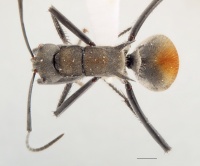Polyrhachis burwelli
| Polyrhachis burwelli | |
|---|---|
| Scientific classification | |
| Kingdom: | Animalia |
| Phylum: | Arthropoda |
| Class: | Insecta |
| Order: | Hymenoptera |
| Family: | Formicidae |
| Subfamily: | Formicinae |
| Tribe: | Camponotini |
| Genus: | Polyrhachis |
| Subgenus: | Hagiomyrma |
| Species group: | ammon |
| Species: | P. burwelli |
| Binomial name | |
| Polyrhachis burwelli Kohout, 2013 | |
This species is known only from the type locality and, in spite of two extensive surveys at Mt Abbot and neighbouring Mt Aberdeen (west of Bowen), the types are the only known specimens of this apparently rare species.
Identification
A member of the ammon species-group in the Polyrhachis subgenus Hagiomyrma. Polyrhachis burwelli is a very distinctive species, characterised by its broad petiolar node with a widely rounded dorsum.
A single worker differs from the specimens of the type series in a virtual lack of any hairs on head, mesosoma and petiole and with only relatively short, erect hairs lining abdominal segments. The closely appressed, silvery pubescence completely absent from the head, dorsum and sides of mesosoma, with only diluted, silvery pubescence on propodeal declivity, petiole and sides and venter of gaster. Gastral dorsum with rich golden with reddish hue, similar to that in specimens of the type series.
Keys including this Species
Distribution
Latitudinal Distribution Pattern
Latitudinal Range: -20.1° to -20.98°.
| North Temperate |
North Subtropical |
Tropical | South Subtropical |
South Temperate |
- Source: AntMaps
Distribution based on Regional Taxon Lists
Australasian Region: Australia (type locality).
Distribution based on AntMaps
Distribution based on AntWeb specimens
Check data from AntWeb
Countries Occupied
| Number of countries occupied by this species based on AntWiki Regional Taxon Lists. In general, fewer countries occupied indicates a narrower range, while more countries indicates a more widespread species. |

|
Estimated Abundance
| Relative abundance based on number of AntMaps records per species (this species within the purple bar). Fewer records (to the left) indicates a less abundant/encountered species while more records (to the right) indicates more abundant/encountered species. |

|
Biology
Castes
Sexuals and immature stages unknown.
Nomenclature
The following information is derived from Barry Bolton's Online Catalogue of the Ants of the World.
- burwelli. Polyrhachis (Hagiomyrma) burwelli Kohout, 2013: 511, figs. 2E-F (w.) AUSTRALIA.
Unless otherwise noted the text for the remainder of this section is reported from the publication that includes the original description.
Description
Worker
(holotype cited first): TL c. 9.98, 9.73-10.68; HL 2.31, 2.18- 2.34; HW 1.96, 1.81-1.96; CI 85, 82-85; SL 3.09, 2.87-3.12; SI 158, 157-159; PW 1.56, 1.47-1.68; MW 1.18, 1.09-1.25; PMI 132, 132-135; MTL 3.83, 3.63-3.83 (3 measured).
Anterior clypeal margin with median, shallowly emarginate, denticulate flange, laterally delimited by acute teeth. Clypeus with median longitudinal carina; weakly sinuate in profile, posteriorly gently rounding into moderately impressed basal margin. Frontal carinae sinuate with distinctly raised margins; central area with shallowly impressed frontal furrow. Sides of head in front of eyes converging towards mandibular bases in very weakly convex line; behind eyes, sides rather narrowly rounding into shallowly convex occipital margin. Eyes convex, situated near occipital corners; in full face view clearly breaking lateral cephalic outline. Ocelli lacking. Pronotal dorsum virtually quadrate with humeri rounded, dorsally shallowly concave; lateral margins narrowly raised, distinctly emarginate at midlength, widely rounding into laterally deeply impressed promesonotal suture. Mesonotum with lateral margins converging posteriorly towards shallow, but distinct metanotal groove. Propodeal dorsum with lateral margins subparallel, widening posteriorly and terminating in relatively broad-based, divergent, acute spines; spines weakly dorso-posteriorly raised at bases and gently turned downwards at midlength. Petiolar node relatively broad in profile with anterior face weakly and posterior face distinctly convex; spines relatively short, widely divergent, with bases situated well below apex of dorsal convexity; length of spines less than one third of distance between tips. Anterior face of first gastral segment widely rounding onto dorsum of gaster.
Mandibles longitudinally striate-rugose with numerous piliferous pits. Mesosoma and petiole finely, head somewhat more coarsely, reticulate-punctate. Gaster shagreened.
Mandibles with numerous, semierect, curved, golden hairs. Medium length, erect hairs on clypeus, along frontal carinae and on vertex, no hairs evident on sides of head between occipital corners and mandibular bases in full face view. Numerous long, erect, golden hairs on dorsum of mesosoma, coxae, venter of femora, petiole and gaster, most hairs longer than greatest diameter of eyes. Silvery or pale golden, appressed pubescence in various densities over most body surfaces, with golden tint on pronotal and mesonotal dorsa. Gastral dorsum with pubescence virtually hiding underlying sculpturation; pubescence rich golden with reddish hue along midline, silvery on gastral sides and venter.
Black with only condylae and apical tarsal segments reddish-brown.
Type Material
- Holotype, worker, Mt Abbot, summit area, Queensland, 750-1000 m, Australia, 20°06′0″S 147°45′0″E / 20.1°S 147.75°E, 8-10.xii.1996, G.B. Monteith & I. Cook, QM T174502, Queensland Museum.
- Paratype, 1 worker, Mt Abbot, summit area, Queensland, 750-1000 m, Australia, 20°06′0″S 147°45′0″E / 20.1°S 147.75°E, 8-10.xii.1996, G.B. Monteith & I. Cook, Queensland Museum.
- Paratype, 1 worker, Mt Abbot, summit area, Queensland, 750-1000 m, Australia, 20°06′0″S 147°45′0″E / 20.1°S 147.75°E, 8-10.xii.1996, G.B. Monteith & I. Cook, Australian National Insect Collection.
Etymology
Named in honour of my colleague, Dr Chris Burwell of the Queensland Museum, in appreciation of his continuing support of my work on Australian Polyrhachis.
References
- Kohout, R.J. 2013. Revision of Polyrhachis (Hagiomyrma) Wheeler, 1911 (Insecta: Hymenoptera: Formicidae: Formicinae). Memoirs of the Queensland Museum, Nature 56, 487-577.

